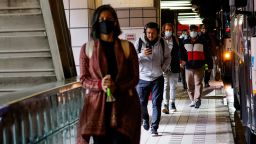As I have said previously, bivalent boosters have been a tough sell. They do work, however, as this report of a study done by the CDC shows. They compared positivity rates on tests done in a pharmacy and compared it to those who had been boosted and those who had not.
This is not the actual study, but a summary of it which is consistent with the numbers that I have seen reported elsewhere.
Updated boosters are cutting the risk of getting sick from Covid-19 by about half
The updated Covid-19 boosters are cutting the risk that a person will get sick from the coronavirus by about half, even against infections caused by the rapidly spreading XBB.1.5 subvariant.
New studies, conducted by researchers at the US Centers for Disease Control and Prevention, are among the first looks at how the bivalent boosters have continued to work in the real world as the virus has evolved. The data shows that the boosters are continuing to offer substantial protection against currently circulating variants.
The near-real-time data was collected by the federally funded Increased Community Access To Testing program, which administers Covid-19 tests through pharmacies. It includes results for adults receiving tests at participating pharmacies from December 1 to January 13.
Of nearly 30,000 test results included in the analysis, more than 13,000 (47%), were positive for Covid-19.
More people who tested negative had gotten an updated bivalent booster compared with those who tested positive.
On average, people in the study who had not gotten a bivalent booster also had not had a dose of a Covid-19 vaccine in more than a year. That’s about the same as the national average, the study authors said. Their protection against illness was probably very minimal, they said.
The study results show that the updated boosters are most effective for younger adults.
For adults between the ages of 18 and 49, the boosters cut the odds of getting a symptomatic infection caused by the BA.5 subvariant by 52%, and it cut the odds of getting an infection caused by XBB or XBB.1.5 by 49%. For adults 50 to 64, the new boosters cut the odds of getting sick with Covid-19 by 43% for BA.5 and 40% for XBB subvariants. For those 65 and older, the boosters cut the odds of an infection with symptoms by 37% and 43% for the BA.5 and XBB subvariants, respectively.
Ruth Link-Gelles, a senior epidemiologist at the CDC and lead study author, said at a news briefing Wednesday that these vaccine effectiveness numbers are averages. Because everyone is unique in terms of their underlying health, their past exposure to the virus and other factors, these estimates of vaccine effectiveness may not apply on an individual level. She said it’s important to think of them on population level.
How long protection lasts
For people who are wondering whether the protection from the bivalent booster they got in September has worn off by now, it’s too early to know how waning would work with these new two-strain shots, Link-Gelles said.
So far, there’s little evidence of waning effectiveness two to three months after people got their shots.
“It’s too early, I think, to know how waning will happen with the bivalent vaccine. We know from the older vaccines that we do see protection decrease over time, especially against symptomatic infection. Just like with overall protection, what we’ve seen in the past is, your protection lasts longer for more severe illness,” Link-Gelles said.
Researchers don’t have data past three months, she said, but based on experience, she would expect protection against severe disease and death to be higher and last longer than these results against infections.
“We will continue to monitor it over time in the coming months,” she said.
The study authors said that these are just estimates of how well the vaccines are protecting people against an infection that brings on symptoms like cough or fever. They are probably working even better against more severe outcomes like hospitalization and death.
“What we know from past experience is generally that the vaccines protect better against more severe disease. So these are estimates for symptomatic infection and we would expect that similar estimates for hospitalization and death would be higher,” Link-Gelles said.
Asked how well the two-strain vaccines may be working compared with the older one-strain shots, Link-Gelles said it was impossible to know.
“We can’t in the US do a direct, head-to-head comparison of the monovalent and the bivalent vaccines because they were never authorized at the same time,” she said. Because protection wanes over time, you’d need to compare groups of people who got each kind of shot at the same time.
“What this tells us is that people that had the bivalent vaccine were better protected than people that were up to date previously, had all their monovalent doses and had not gotten the bivalent vaccine,” Link-Gelles said.
CDC sped study results
The CDC said it was able analyze the data and publish it so quickly thanks to the use of a shortcut. Rather than sequencing the genomes of each positive result, the researchers relied on a different marker to distinguish between variants.
The tests used in the study rely on a series of probes, or markers, to identify a positive case. Some variants of the virus that causes Covid-19 have mutations in their spike protein that causes one of the test markers to fail. This is called an S-gene target failure.
In the study, test results that showed an S-gene target failure were considered to be an infection caused by a BA.5 subvariant. Those that were S-gene target positive were considered to be caused by the XBB or XBB.1.5 sublineage.







